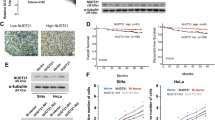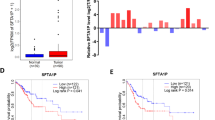Abstract
ADP-ribosylation factor-like 6 interacting protein 1 (ARL6IP1) is an apoptotic regulator. To investigate the role of ARL6IP1 in human cervical cancer progression, we designed and used short hairpin RNA (shRNA) to inhibit ARL6IP1 expression in CaSki cells and validated its effect on cell proliferation and invasion. Changes in gene expression were analyzed by reverse transcriptase-polymerase chain reaction (RT-PCR) or western blot. Down-regulation of ARL6IP1 expression by infection with ARL6IP1-specific RNAi-expressing vector inhibited CaSki cell proliferation and colony formation. In addition, down-regulation of ARL6IP1 expression arrested CaSki cell cycling at the G0/G1 phase and mitigated CaSki cell migration, determined by wound healing assays. ARL6IP1 was involved in cervical cancer cell growth, cell cycle progression, and invasion through regulation of gene expression, such as Caspase-3, Caspase-9, p53, TAp63, NF-κB, MAPK, Bcl-2, and Bcl-xL, suggesting that ARL6IP1 could have important implications in cervical cancer biology. Our findings illustrate the biological significance of ARL6IP1 in cervical cancer progression, and provide novel evidence that ARL6IP1 may serve as a therapeutic target in the prevention of human cervical cancer.





Similar content being viewed by others
References
DiPaolo JA, Alvarez-Salas LM (2004) Advances in the development of therapeutic nucleic acids against cervical cancer. Expert Opin Biol Ther 4:1251–1264. doi:10.1517/14712598.4.8.1251
Parkin DM, Bray F, Ferlay J (2005) Global cancer statistics. CA Cancer J Clin 55:74–108. doi:10.3322/canjclin.55.2.74
Wyllie AH, Morris RG, Smith AL, Dunlop D (1984) Chromatin cleavage in apoptosis: association with condensed chromatin morphology and dependence on macromolecular synthesis. J Pathol 142:67–77. doi:10.1002/path.1711420112
Stellar H (1995) Mechanisms and genes of cellular suicide. Science 267:1445–1449. doi:10.1126/science.7878463
Ingley E, Williams JH, Walker CE, Tsai S, Colley S, Sayer MS, Tilbrook PA, Sarna M, Beaumont JG, Klinken SP (1999) A novel ADP-ribosylation like factor (ARL-6), interacts with the protein-conducting channel SEC61beta subunit. FEBS Lett 459:69–74. doi:10.1016/S0014-5793(99)01188-6
Lui HM, Chen J, Wang L, Naumovski L (2003) ARMER, apoptotic regulator in the membrane of the endoplasmic reticulum, a novel inhibitor of apoptosis. Mol Cancer Res 1:508–518
Pettersson M, Bessonova M, Gu HF, Groop LC, Jönsson JI (2000) Characterization, chromosomal localization, and expression during hematopoietic differentiation of the gene encoding Arl6ip, ADP-ribosylation-like factor-6 interacting protein (ARL6). Genomics 68:351–354. doi:10.1006/geno.2000.6278
Akiduki S, Ikemoto MJ (2008) Modulation of the neural glutamate transporter EAAC1 by the addicsin-interacting protein ARL6IP1. J Biol Chem 283:31323–31332. doi:10.1074/jbc.M801570200
Wang GL, Shi X, Salisbury E, Timchenko NA (2008) Regulation of apoptotic and growth inhibitory activities of C/EBPalpha in different cell lines. Exp Cell Res 314:1626–1639. doi:10.1016/j.yexcr.2008.01.028
Li S, Chai Z, Li Y, Liu D, Bai Z, Li Y, Li Y, Situ Z (2009) BZW1, a novel proliferation regulator that promotes growth of salivary muocepodermoid carcinoma. Cancer Lett 284:86–94. doi:10.1016/j.canlet.2009.04.019
Shen Y, White E (2001) p53-dependent apoptosis pathways. Adv Cancer Res 82:55–84
Daniel NN, Korsmeyer SJ (2004) Cell death: critical control points. Cell 116:205–219. doi:10.1016/S0092-8674(04)00046-7
Oltersdorf T, Elmore SW, Shoemaker AR, Armstrong RC, Augeri DJ, Belli BA, Bruncko M, Deckwerth TL, Dinges J, Hajduk PJ, Joseph MK, Kitada S, Korsmeyer SJ, Kunzer AR, Letai A, Li C, Mitten MJ, Nettesheim DG, Ng S, Nimmer PM, O’Connor JM, Oleksijew A, Petros AM, Reed JC, Shen W, Tahir SK, Thompson CB, Tomaselli KJ, Wang B, Wendt MD, Zhang H, Fesik SW, Rosenberg SH (2005) An inhibitor of Bcl-2 family proteins induces regression of solid tumours. Nature 435:677–681. doi:10.1038/nature03579
Farhana L, Dawson MI, Fontana JA (2005) Apoptosis induction by a novel retinoid-related molecule requires nuclear factor-kappaB activation. Cancer Res 65:4909–4917
Santen RJ, Song RX, McPherson R, Kumar R, Adam L, Jeng MH, Yue W (2002) The role of mitogen-activated protein (MAP) kinase in breast cancer. J Steroid Biochem Mol Biol 80:239–256. doi:10.1016/S0960-0760(01)00189-3
Cristofanilli M (2006) Circulating tumor cells, disease progression, and survival in metastatic breast cancer. Semin Oncol 33:S9–S14. doi:10.1016/S0960-0760(01)00189-3
Gao CF, Xie Q, Su YL, Koeman J, Khoo SK, Gustafson M, Knudsen BS, Hay R, Shinomiya N, Vande Woude GF (2005) Proliferation and invasion: plasticity in tumor cells. Proc Natl Acad Sci USA 102:10528–10533. doi:10.1073/pnas.0504367102
Arakawa H (2005) p53, apoptosis and axon-guidance molecules. Cell Death Differ 12:1057–1065. doi:10.1038/sj.cdd.4401601
Zhao S, Zhang J, Zhang X, Dong X, Sun X (2008) Arsenic trioxide induces different gene expression profiles of genes related to growth and apoptosis in glioma cells dependent on the p53 status. Mol Biol Rep 35:421–429. doi:10.1007/s11033-007-9102-6
Petrova RD, Mahajna J, Wasser SP, Ruimi N, Denchev CM, Sussan S, Nevo E, Reznick AZ (2009) Marasmius oreades substances block NF-kappaB activity through interference with IKK activation pathway. Mol Biol Rep 36:737–744. doi:10.1007/s11033-008-9237-0
Park SY, Park GY, Ko WS, Kim YH (2009) Dichroa febrifuga Lour. inhibits the production of IL-1beta and IL-6 through blocking NF-kappaB, MAPK and Akt activation in macrophages. J Ethnopharmacol 125:246–251. doi:10.1016/j.jep.2009.07.003
Liu H, Zhang T, Wu B, Huang J, Zhou Y, Zhu J (2009) Chronic exposure to exogenous matrilysin induces chemoresistance and enhances Bcl-2 expression in A549 lung adenocarcinoma cells. Mol Biol Rep 36:2099–2109. doi:10.1007/s11033-008-9422-1 Epub 2008 Dec 24. PubMed PMID: 19107575
Lee SH, Park SM, Park SM, Park JH, Shin DY, Kim GY, Ryu CH, Shin SC, Jung JM, Kang HS, Lee WS, Choi YH (2009) Induction of apoptosis in human leukemia U937 cells by anthocyanins through down-regulation of Bcl-2 and activation of caspases. Int J Oncol 34:1077–1083
Reed JC (1997) Double identity for proteins of the Bcl-2 family. Nature 387:773–776. doi:10.1038/42867
Acknowledgments
This study was supported by a grant from the National Natural Science Foundation of China (No. 30672352).
Author information
Authors and Affiliations
Corresponding author
Electronic supplementary material
Below is the link to the electronic supplementary material.
Rights and permissions
About this article
Cite this article
Guo, F., Liu, Y., Li, Y. et al. Inhibition of ADP-ribosylation factor-like 6 interacting protein 1 suppresses proliferation and reduces tumor cell invasion in CaSki human cervical cancer cells. Mol Biol Rep 37, 3819–3825 (2010). https://doi.org/10.1007/s11033-010-0037-y
Received:
Accepted:
Published:
Issue Date:
DOI: https://doi.org/10.1007/s11033-010-0037-y




